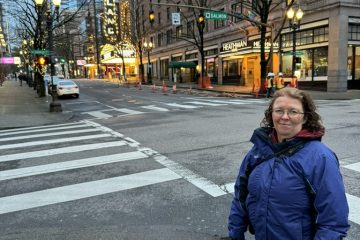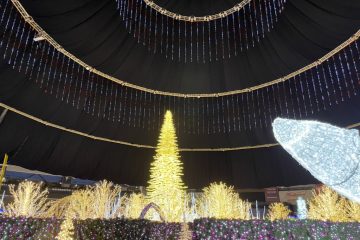Sometimes, you have to put your hands into fate and enjoy what comes. This trip started out “planned”. I wanted to take Teresa to Colorado Springs for our anniversary trip. I was just a young boy when dad was stationed there, but I remembered Pike’s Peak, the zoo where you could feed the giraffes, and Santa Claus land. I remembered the natural beauty that was the Royal Gorge, Garden of the Gods and Seven Falls. I wanted to share some of that with her. We also were big into geocaching too and wanted to “cache” along the road trip. As the trip got closer, we loosely planned where we wanted to go and see. There was no order and we could not decide whether to geocache all the way there and then drive straight back, or drive straight there and geocache our way back. Both had their pro’s and con’s. We decided to flip a coin. And so began our trip of fate.
Trip of Fate
It is not easy putting your decisions into fate or chance. You make thousands of decisions a day from when to get up, what to wear, what to eat, where to go, where to work (and how to get there) and more. How could you handle flipping a coin and accepting that decision, that fate? Well after the first coin flip, we decided we wanted to try. We decided that for every major decision like left or right, do this or not, stop here or not, etc or not that we would flip the coin. Heads we would do it or tails we would not. Heads was left and tails was right. And, we had to commit to live with the decision or fate. And so we did. The first decision was decided, we drove straight through to Colorado Springs. It was a 15 hour mostly interstate drive, so we did make one stop in Kansas along the way.
Colorado Springs
My dad was Army and had tours in Korea and Vietnam. He worked his way up from enlisted to officer. During his tour in Vietnam, he was “stationed” at Ft Carson in Colorado Springs. Well, we lived their. I was very young (3-4 years) and as I said above, have fragments of memories. Teresa’s dad also served, in WW II. He too was army. Not that there is anything wrong with the other services.
Air Force Academy
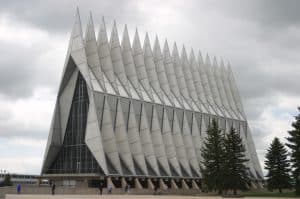
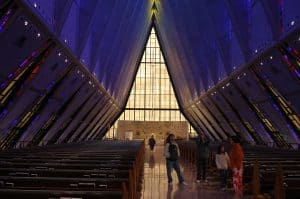 There is nothing like the chapel at the Air Force Academy. It is awe inspiring, for a “modern” church. It houses sanctuaries for several denominations. Perhaps the rest of the world could take a lesson from the academy.
There is nothing like the chapel at the Air Force Academy. It is awe inspiring, for a “modern” church. It houses sanctuaries for several denominations. Perhaps the rest of the world could take a lesson from the academy.
The United States Air Force Academy Cadet Chapel, completed in 1962, is the distinguishing feature of the Cadet Area at the United States Air Force Academy north of Colorado Springs. Originally controversial in its design, the Cadet Chapel has become a classic and highly regarded example of modernist architecture. The Cadet Chapel was awarded the American Institute of Architects’ National Twenty-five Year Award in 1996 and, as part of the Cadet Area, was named a U.S. National Historic Landmark in 2004. (Source)
Pikes Peak
 When visiting Colorado Springs, there are several “must-see” places and one of those is Pike’s Peak.
When visiting Colorado Springs, there are several “must-see” places and one of those is Pike’s Peak.
Pikes Peak is the highest summit of the southern Front Range of the Rocky Mountains, in North America. The ultra-prominent 14,115-foot (4,302.31 m) fourteener is located in Pike National Forest, 12 miles (19 km) west of downtown Colorado Springs, Colorado. The mountain is named in honor of American explorer Zebulon Pike, who was unable to reach the summit. The summit is higher than any point in the United States east of its longitude. (source).
There is a rod to the summit and a cogwheel train also lets you get to the top. There are races, both car and bike races to the top. There are also several stops along the way to the summit. Once there, on clear days, the view is breath taking. It compares to Mount Pilatus in Switzerland.
Garden of the Gods
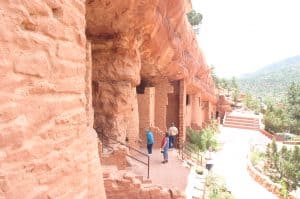
Another must see is “Garden of the Gods”. It is a natural park area with some stunning rock formations.
The area now known as Garden of the Gods was first called Red Rock Corral by the Europeans. Then, in August 1859, two surveyors who helped to set up Colorado City explored the site. One of the surveyors, M. S. Beach, suggested that it would be a “capital place for a beer garden”. His companion, the young Rufus Cable, awestruck by the impressive rock formations, exclaimed, “Beer Garden! Why it is a fit place for the Gods to assemble. We will call it the Garden of the Gods.” (source)
During our drive, we had packed camping gear. We had wanted to spend some time more in nature and the last time I had made a road trip through here, there was a nice campground near Cripple Creek. Well, it was May and at a high elevation, so the weather was cool (down right cold at night). We had sleeping gear that would have worked, but when we tried to check in, the camp manager said a cold front was coming through and felt it would better for us to stay in a cabin. Teresa and I looked at each other. We wanted to camp, but were also taking the manager’s advice in consideration. We decided it was one of those times to flip the coin. It said to move on and we did. We ended up camping, but at a campground with a much lower elevation. The front moved through that night and the wind was brutal. We would have survived the cold, but the wind cutting through might now have been good. We later found out that the campground we had first stopped at got snowed in.
Seven Falls
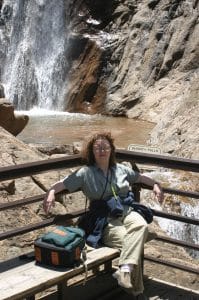
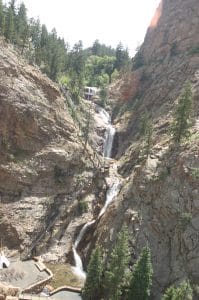 Another wonder, especially at night when all lit up is “Seven Falls”. It has been a privately owned park for as long as I can remember and each waterfall has a different name. You can hike to the top for “inspiration”.
Another wonder, especially at night when all lit up is “Seven Falls”. It has been a privately owned park for as long as I can remember and each waterfall has a different name. You can hike to the top for “inspiration”.
The Seven Falls is a series of seven cascading waterfalls of South Cheyenne Creek in South Cheyenne Cañon, Colorado Springs, Colorado. It is a privately owned tourist attraction since it was opened in the early 1880s. Trails from the top of the falls lead to Midnight Falls, near the headwaters of South Cheyenne Creek, and Inspiration Point. (source).
While the walk up is tiring and you should stop often to re-hyrdate, it is worth the climb.
Royal Gorge
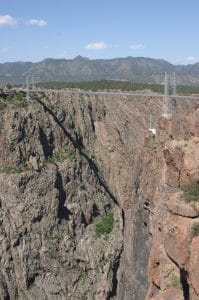 Much of the sites were must see’s, the next one found us with a dilemma. I remember visiting this site with my grandparents when they came out to visit. The bridge, the high suspension bridge in the US, was scary for a child, let alone adults. Since that time, the park as put up an amusement park in front of the entrance and charged admission. We did not feel like riding rides (they looked like kiddie carnival rides), but we wanted to see the bridge. So, we flipped the coin and the coin said “no”. We were able to find a few vantage points to get some pictures, but it was not the same.
Much of the sites were must see’s, the next one found us with a dilemma. I remember visiting this site with my grandparents when they came out to visit. The bridge, the high suspension bridge in the US, was scary for a child, let alone adults. Since that time, the park as put up an amusement park in front of the entrance and charged admission. We did not feel like riding rides (they looked like kiddie carnival rides), but we wanted to see the bridge. So, we flipped the coin and the coin said “no”. We were able to find a few vantage points to get some pictures, but it was not the same.
The Royal Gorge is a canyon of the Arkansas River located west of Cañon City, Colorado. The canyon begins at the mouth of Grape Creek about 2 mi (3.2 km) west of central Cañon City and continues in a west-northwesterly direction for approximately 6 mi (9.7 km) until ending near U.S. Route 50. Being one of the deepest canyons in Colorado, it is also known as the Grand Canyon of the Arkansas (River), with a maximum depth of 1,250 ft (380 m). The canyon is also very narrow, measuring from 50 ft (15 m) wide at its base to 300 ft (91 m) wide at its top, as it carves a path through the granite formations below Fremont Peak and YMCA Mountain, which rise above the north and south rims, respectively.
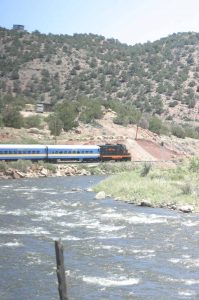 We stopped on the way out at a small winery back towards Cañon city. Again, we flipped a coin on whether to buy any (again, the coin said “no”). As we were getting back in the car, we saw a sign that said “see the Royal Gorge Bridge from another vantage point” and had a picture of a train.
We stopped on the way out at a small winery back towards Cañon city. Again, we flipped a coin on whether to buy any (again, the coin said “no”). As we were getting back in the car, we saw a sign that said “see the Royal Gorge Bridge from another vantage point” and had a picture of a train.
 We followed the signs to a train station and asked the coin if we should venture forth on a train ride through the canyon, along the Arkansas River. The coin said “yes”. We went to buy tickets and faced another decision, first class or not. Again, the coin said “yes”.
We followed the signs to a train station and asked the coin if we should venture forth on a train ride through the canyon, along the Arkansas River. The coin said “yes”. We went to buy tickets and faced another decision, first class or not. Again, the coin said “yes”.
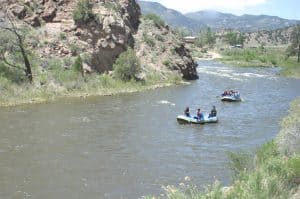 Riding through the canyon, we saw people i rafts braving the river and old aqueducts used for mining. There was wildlife and the smell of the open air and pine trees was amazing. Then came the bridge itself. It was a different site to see it from below.
Riding through the canyon, we saw people i rafts braving the river and old aqueducts used for mining. There was wildlife and the smell of the open air and pine trees was amazing. Then came the bridge itself. It was a different site to see it from below.
The Royal Gorge Route Railroad is a heritage railroad located in Cañon City, Colorado. The railroad transits the Royal Gorge on a 2-hour scenic and historic train ride along what is considered to be the most famed portion of the former Denver and Rio Grande Western Railroad. The 1950s-era train departs the Santa Fe Depot in Cañon City daily. (source)
Our time in Colorado was coming to an end, but not our journey. We had been “geocaching” while in Colorado Springs, but we wanted to get in the country too. Time to head into Kanas.
Kansas
We’ve heard there is nothing in Kansas but wheat fields and plains. I can tell you that driving the interstate across state that I can see why they say that. Since we wanted to see more than just the interstate, we took the state roads back. There were hundreds of caches to find.
Garden City
After several caches, we were approaching a town called Garden City. It was getting late. I looked at the clock and it was near 10pm. We weren’t tired though and the it seemed like the sun had just set. The light on the horizon got brighter and we noticed a halo or haze seemed to hang over the town.
Then it hit us, the smell. What was it? There was no hiding from it. Even if we put the top up, we felt it was strong enough to permeate that. As we got closer, we saw the signs for a fertilizer plant. Well, it is called Garden City. Fortunately it was on the west side on town and by the time we got the to the east side, we were able to find a hotel away from the smell.
We got up early to cache and head towards Dodge city.
Dodge City
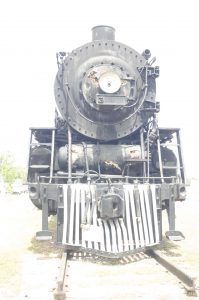
Dodge City has a lot of history, a major stop along the Santa Fe trail and with the railroad. There are stories of “cowboy heroes” and “notorious outlaws” all around the Dodge City area.
Fort Mann was the first settlement of nonindigenous people in the area that became Dodge City, built by civilians in 1847 (then the territory being part of Mexico) to provide protection for travelers on the Santa Fe Trail. Fort Mann collapsed in 1848 after an Indian attack. In 1850, the U.S. Army arrived to provide protection in the region and constructed Fort Atkinson on the old Fort Mann site. The army abandoned Fort Atkinson in 1853. Military forces on the Santa Fe Trail were re-established farther north and east at Fort Larned in 1859, but the area remained vacant around what would become Dodge City until the end of the Civil War. In April 1865, the Indian Wars in the West began heating up, and the army constructed Fort Dodge to assist Fort Larned in providing protection on the Santa Fe Trail. Fort Dodge remained in operation until 1882. (source)
Along the way, we found an small town with an old-fashioned soda fountain (though we did not find the nearby cache). While we were sitting there, an older woman came in asking who was driving the car with out of town plates. We waved and she came and sat beside us. She was a chatty cathy and told us about the town and the area. She was proud of her heritage. She invited us out to the farm, saying they had a cow ready to give birth. We declined, politely and finished our milkshakes and left.
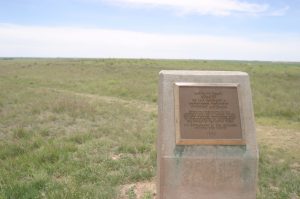
One cache took us to the markers along the Santa Fe trail. It was amazing to see ruts still scarring the land from so long ago.
The Santa Fe Trail was a 19th-century transportation route through central North America that connected Independence, Missouri with Santa Fe, New Mexico. Pioneered in 1821 by William Becknell, it served as a vital commercial highway until the introduction of the railroad to Santa Fe in 1880. Santa Fe was near the end of the El Camino Real de Tierra Adentro, which carried trade from Mexico City.
The route skirted the northern edge and crossed the north-western corner of Comancheria, the territory of the Comanches, who demanded compensation for granting passage to the trail, and represented another market for American traders. Comanche raiding farther south in Mexico isolated New Mexico, making it more dependent on the American trade, and provided the Comanches with a steady supply of horses for sale. By the 1840s, trail traffic along the Arkansas Valley was so heavy that bison herds could not reach important seasonal grazing land, contributing to their collapse, which in turn hastened the decline of Comanche power in the region.
As I said, we flipped the coin for left or right, stop or go on and the coin led us into a Kansas city of Hutchinson. There were parks and caches galore here, but it held something more amazing. It was home to the Cosmosphere.
Hutchinson (Cosmosphere)
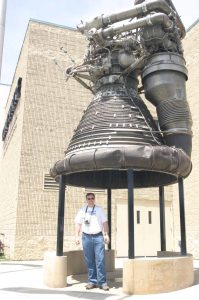
Wait! What? Did you say a space museum? In Kansas? It has to be a road side stand, a tourist trap, something. Well, it is not. It is museum which boasts the largest collection of space artifacts in the world. Yes, the world!
Cosmosphere is a space museum and STEM education center in Hutchinson, Kansas, United States. It was previously known as the Kansas Cosmosphere. The museum houses over 13,000 spaceflight artifacts – the largest combined collection of US and Russian spaceflight artifacts in the world, and is home to internationally acclaimed educational programs. (source)
It was such a cool find… in Kansas. And yes, there were caches there too. I am not sure though if we would have found it if it had not been for our coin, our fate. We stayed the night in Hutchinson before moving onto Illinois, caching the rest of the ay home.

